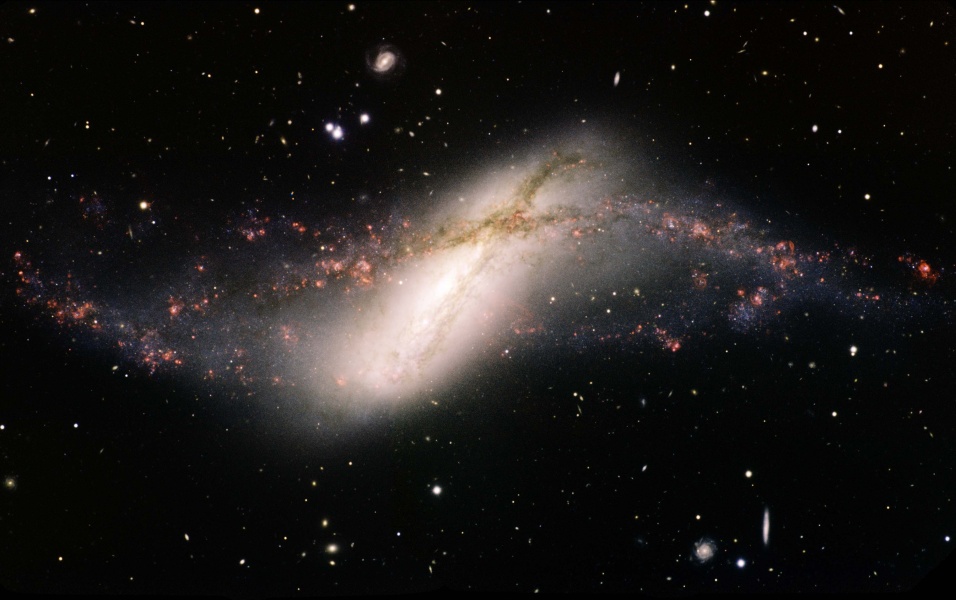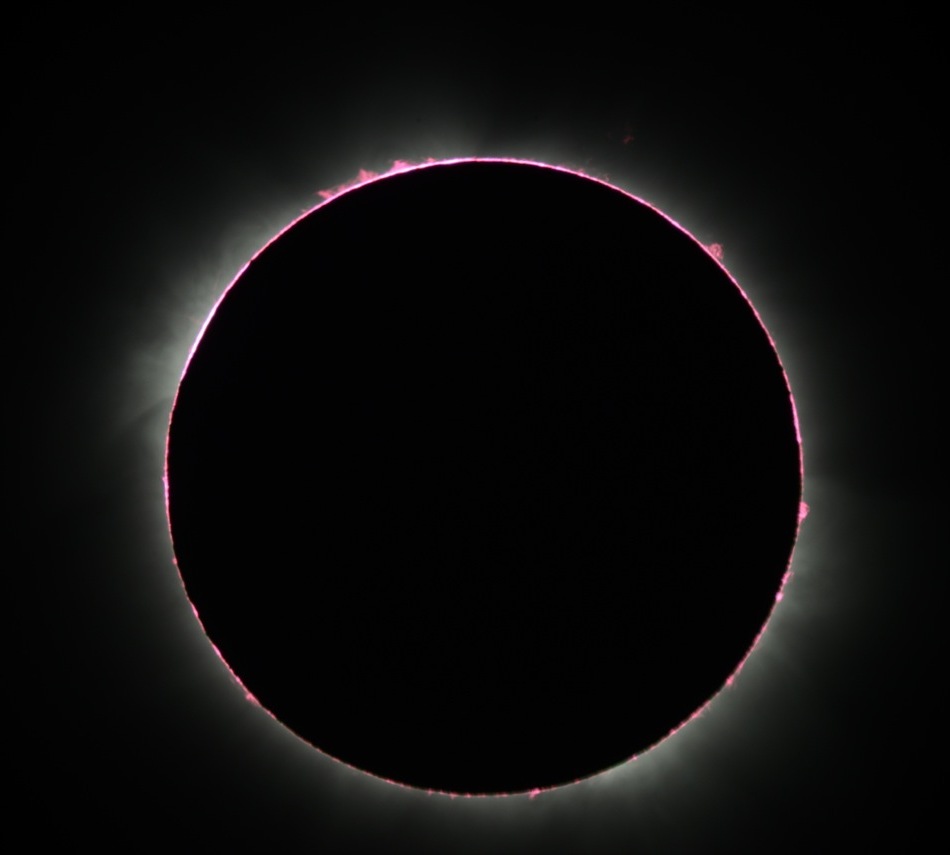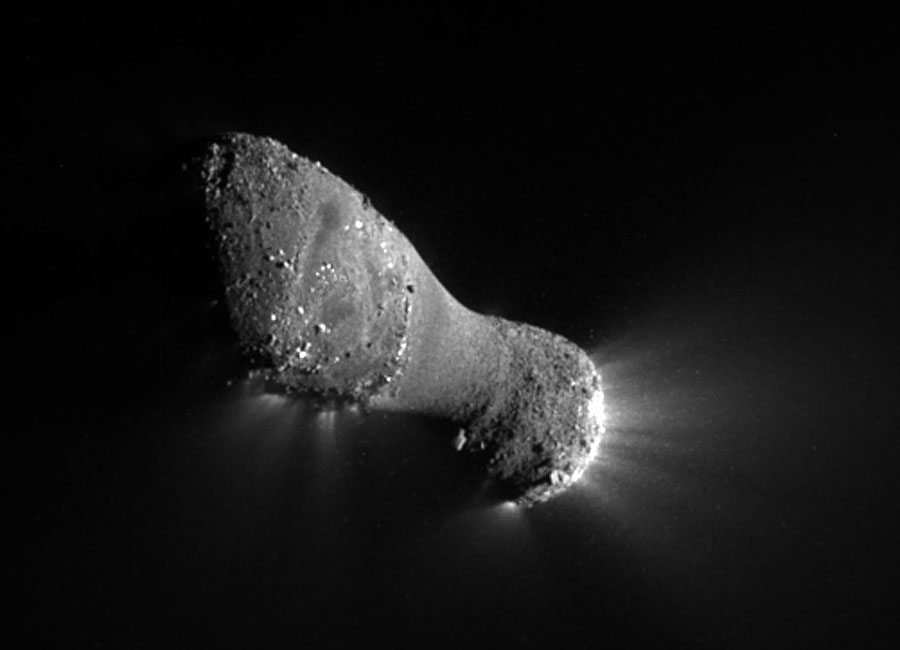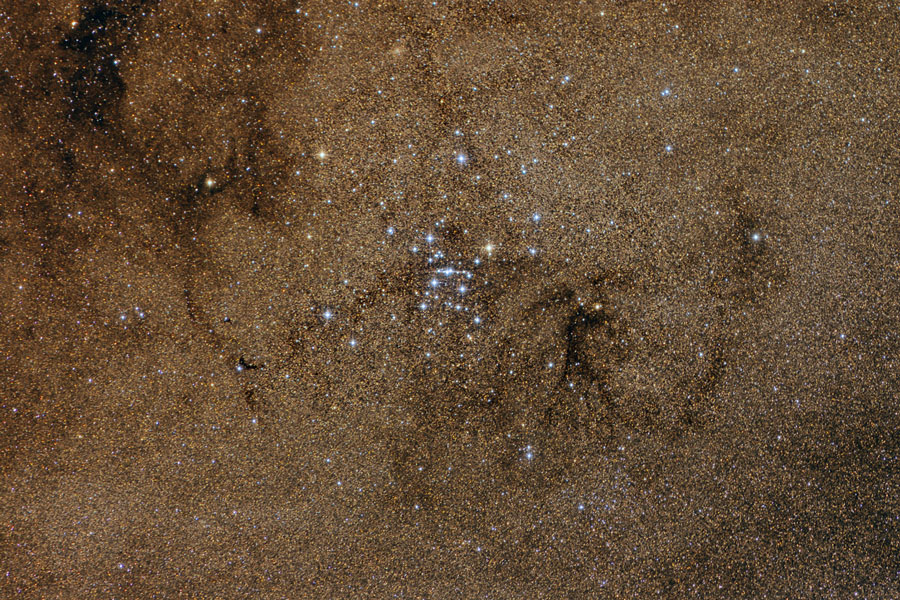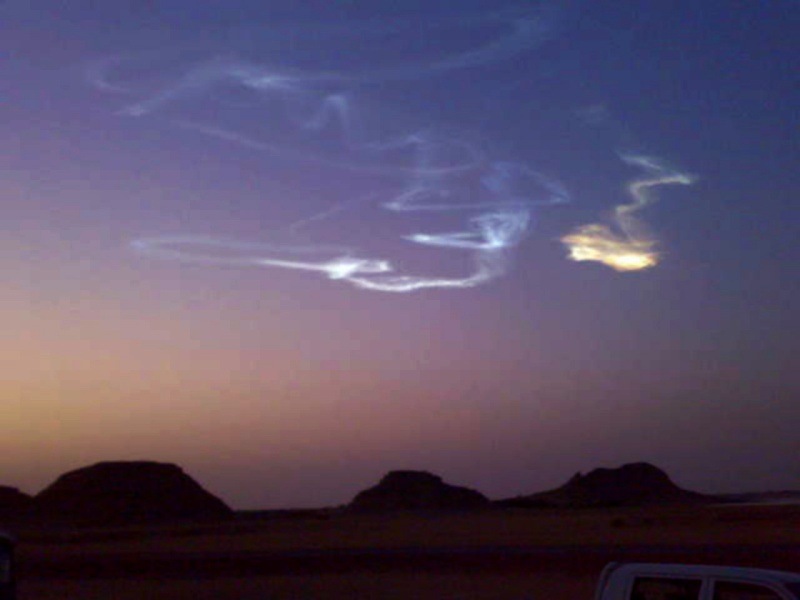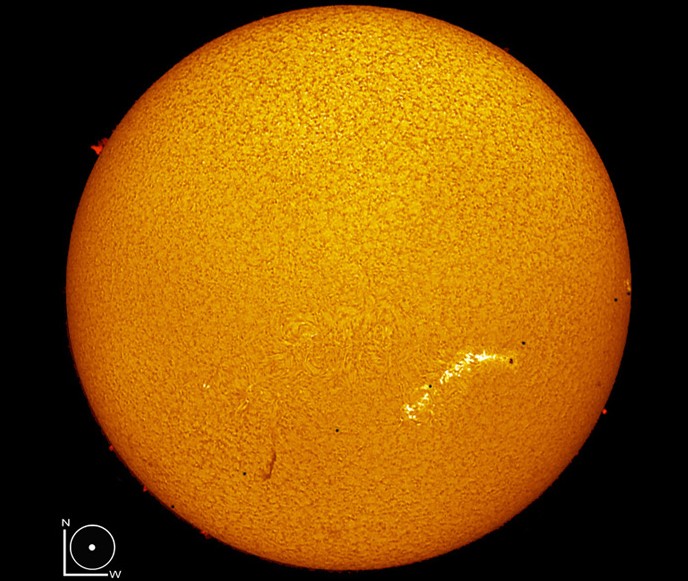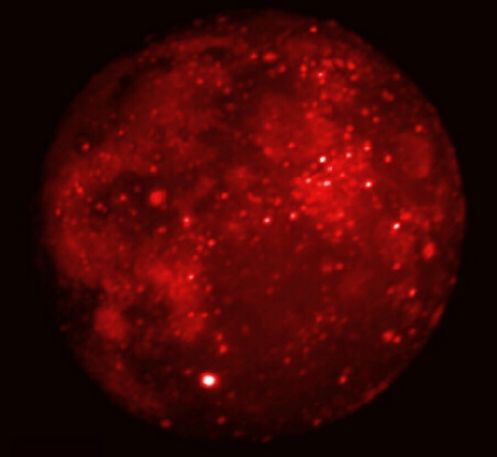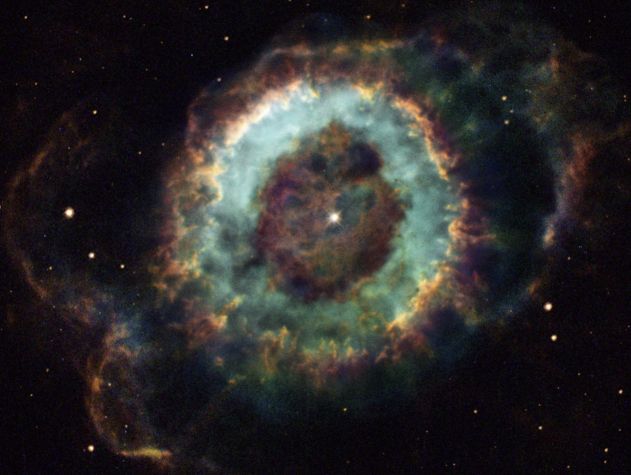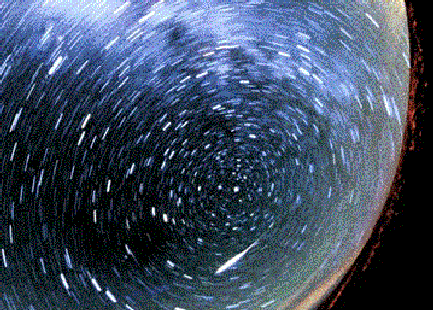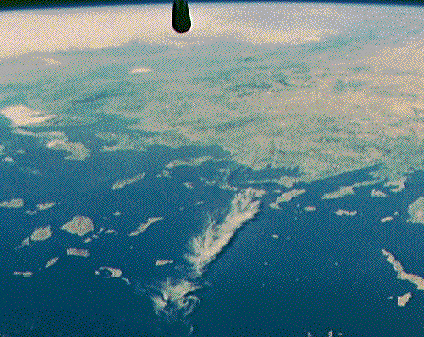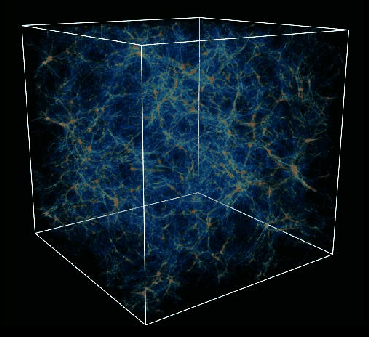| << Previous | Index | Next >> |
2014 NGC 660 is featured in this cosmic snapshot, a sharp composite of broad and narrow band filter image data from the Gemini North telescope on Mauna Kea. Over 20 million light-years away and swimming within the boundaries of the constellation Pisces, NGC 660's peculiar appearance marks it as a polar ring galaxy. A rare galaxy type, polar ring galaxies have a substantial population of stars, gas, and dust orbiting in rings nearly perpendicular to the plane of the galactic disk. The bizarre-looking configuration could have been caused by the chance capture of material from a passing galaxy by a disk galaxy, with the captured debris eventually strung out in a rotating ring. The violent gravitational interaction would account for the myriad pinkish star forming regions scattered along NGC 660's ring. The polar ring component can also be used to explore the shape of the galaxy's otherwise unseen dark matter halo by calculating the dark matter's gravitational influence on the rotation of the ring and disk. Broader than the disk, NGC 660's ring spans over 50,000 light-years.
2013 The Sun's disk was totally eclipsed for a brief 20 seconds as the Moon's dark umbral shadow raced across Pokwero in northwestern Uganda on November 3rd. So this sharp telescopic view of totality in clear skies from the central African locale was much sought after by eclipse watchers. In the inspiring celestial scene the Moon just covers the overwhelmingly bright photosphere, the lower, normally visible layer of the Sun's atmosphere. Extending beyond the photosphere, the reddish hydrogen alpha glow of the solar chromosphere outlines the lunar silhouette, fading into the Sun's tenuous, hot, outer atmosphere or corona. Planet-sized prominences reaching beyond the limb of the active Sun adorn the edges of the silhouette, including a cloud of glowing plasma separated from the chromosphere near the 1 o'clock position.
2012
2011
Click to play embedded YouTube video.
Image Credit: abrigatti, YouTube
2010 What kind of comet is this? Last week, NASA's robotic EPOXI spacecraft whizzed past Comet 103P/Hartley, also known as Comet Hartley 2, and recorded images and data that are both strange and fascinating. EPOXI was near its closest approach -- about 700 kilometers away -- when it snapped the above picture. As expected, the comet has indeed shown itself to be a tumbling iceberg orbiting the Sun between Earth and Jupiter. However, unexpected features on the images have raised many questions. For example, where are all the craters? Why is there a large smooth area around the middle? How much of Comet Hartley 2 is a loose pile of dust and ice shards? Future analyses and comparisons to other comet nuclei may answer some of these questions and, hopefully, lead to a better general understanding of comets, meteors, and the early Solar System.
2009 M7 is one of the most prominent open clusters of stars on the sky. The cluster, dominated by bright blue stars, can be seen with the naked eye in a dark sky in the tail of the constellation of the Scorpion (Scorpius). M7 contains about 100 stars in total, is about 200 million years old, spans 25 light-years across, and lies about 1000 light-years away. The above deep exposure was taken last month over several nights from Yalbraith, NSW, Australia. The M7 star cluster has been known since ancient times, being noted by Ptolemy in the year 130 AD. Also visible are a dark dust cloud and literally millions of unrelated stars towards the Galactic center.
2008
2007 Early morning risers and late to bed astronomers have recently enjoyed bright planets in predawn skies, with brilliant Venus above the eastern horizon. On November 5, Venus was joined by the waning crescent Moon. This self-portrait by astronomer Larry Ciupik captures the lovely pairing of the two brightest celestial beacons on the scene, though the Moon, right of Venus, is strongly over exposed. Included at the far left in the 30 second exposure is the bright streak of the International Space Station still docked with shuttle orbiter Discovery. Together in Earth orbit, the spacefaring combination was momentarily the third brightest sky light in view. In dim silhouette, a multi-mirrored unit of the Very Energetic Radiation Imaging Telescope Array System (VERITAS) is also visible in the foreground. VERITAS operates at the Whipple Observatory near Tucson, Arizona to detect high-energy gamma-rays from the cosmos.
2006 Mercury, the solar system's innermost planet, will spend about five hours crossing in front of the Sun today - beginning at 1912 UT (2:12pm EST), November 8. Specially equipped telescopes are highly recommended to safely spot the planet's diminutive silhouette however, as Mercury should appear about 200 times smaller than the enormous solar disk. This simulated view is based on a filtered solar image recorded on November 3rd. It shows active regions and the Mercury transit across the Sun at six positions from lower left to middle right. Depending on your location, the Sun may not be above the horizon during the entire transit, but webcasts of the event are planned - including one using images from the sun-staring SOHO spacecraft. This is the second of 14 transits of Mercury during the 21st century. The next similar event will be a transit of Venus in June of 2012.
2005 What would it be like to walk across Mars? The robot Opportunity rover is currently experiencing what it is like to roll across part of the red planet. It's not always easy -- the rover is being instructed to dodge the deeper drifts of dark sand. During its exploration of Erebus Crater, the rover stopped and took the above picture. Inside this part of Erebus Crater, the surface of mars is covered not only by dark sand but also light outcrops of rock. Scattered across the exposed rock are numerous small round pebbles known as blueberries . Typically smaller than marbles, these unexpected and unusual rocks likely formed by accretion in an ancient wet environment. Also visible are some strange protruding edges known as razorbacks. The above image was taken early last month.
2004 What are those bright objects in the morning sky? Early morning dog walkers, among many others across our world's Northern Hemisphere, have likely noticed tremendously bright Venus hanging in the eastern sky just before sunrise. Looking a bit like an approaching airplane, Venus holds its place in the sky and never seems to land. Last week, impressive but less bright Jupiter appeared within a degree of the Venusian orb, creating a dazzling sky that you might appreciate a bit more than your dog. This night sky early show will change slightly over the next week, with the planets moving past each other, Mars moving into the picture, guest stars like Spica appearing to shift in the background, and even a crescent Moon stopping in for a cameo. Pictured above last week, Jupiter and Venus were photographed rising before the Sun over the city of Bursa, Turkey.
2003 The total lunar eclipse of September 1996 disappointed many observers in North America who were cursed with cloudy skies. However, the Midcourse Space Experiment (MSX) satellite had a spectacular view from Earth orbit and SPIRIT III, an on board infrared telescope, was used to repeatedly image the moon during the eclipse. Above is one of the images taken during the 70 minute totality, the Moon completely immersed in the Earth's shadow. Infrared light has wavelengths longer than visible light - humans can not see it but feel it as heat. The bright spots correspond to the warm areas on the lunar surface, dark areas are cooler. The brightest spot below and left of center is the crater Tycho, the dark region at the upper right is the Mare Crisium. The series of SPIRIT III images allow the determination of cooling rates for geologically different areas, exploring the physical properties of the Moon's surface.
2002 This pretty planetary nebula, cataloged as NGC 6369, was discovered by 18th century astronomer William Herschel as he used a telescope to explore the constellation Ophiucus. Round and planet-shaped, the nebula is also relatively faint and has acquired the popular moniker of Little Ghost Nebula. Planetary nebulae in general are not at all related to planets, but instead are created at the end of a sun-like star's life as its outer layers expand into space while the star's core shrinks to become a white dwarf. The transformed white dwarf star, seen near the center, radiates strongly at ultraviolet wavelengths and powers the expanding nebula's glow. Surprisingly complex details and structures of NGC 6369 are revealed in this delightful color image composed from Hubble Space Telescope data. The nebula's main ring structure is about a light-year across and the glow from ionized oxygen, hydrogen, and nitrogen atoms are colored blue, green, and red respectively. Over 2,000 light-years away, the Little Ghost Nebula offers a glimpse of the fate of our Sun, which should produce its own pretty planetary nebula only about 5 billion years from now.
2001 At the Sun's surface, sunspots are known to be dark, planet-sized regions of intense magnetic fields. But what lies below? Using observations from the Michelson Doppler Imager (MDI) instrument aboard the space-based SOHO observatory, astronomers have derived this premier picture of the flow of material just beneath a visible sunspot. The MDI data indicate that immediately under the sunspot a strong inflowing current exists, shown above by the dark arrows. This converging undertow pulls near-surface material toward the spot and prevents the concentrated magnetic fields from flying apart, like repelling poles of iron magnets. Such a configuration appears to divert the normal flow of plasma bubbling up from the solar interior, creating a self-sustaining sunspot. The MDI instrument can explore the properties of the solar interior by detecting motions produced by sound waves as they interact at the solar surface.
2000 With brilliant Venus above the western horizon at sunset and Jupiter and Saturn high in the east by early evening, November's night sky is filled with bright planets. October's sky featured bright planets as well and, triggered by the active Sun, some lovely auroral displays. This colorful aurora was recorded by astrophotographer Wade Clark in skies above Hamilton, Washington, USA on the night of October 4th. Through the shimmering northern lights Jupiter and Saturn are easy to spot flanking the V-shaped head of Taurus the Bull. Of course, just above lies the lovely Pleiades star cluster. Solar activity will also produce auroral shows in November, particularly at high northern and southern latitudes. Plus, November skygazers can certainly anticipate a celestial performance on the evening of the 17th/18th -- the moonlit Leonid meteor shower.
1999 Our Moon's appearance changes nightly. This slow-loading time-lapse sequence shows what our Moon looks like during a lunation, a complete lunar cycle. As the Moon orbits the Earth, the half illuminated by the Sun first becomes increasingly visible, then decreasingly visible. The Moon always keeps the same face toward the Earth. The Moon's apparent size changes slightly, though, and a slight wobble called a libration is discernable as it progresses along its elliptical orbit. During the cycle, sunlight reflects from the Moon at different angles, and so illuminates different features differently. A full lunation takes about 29.5 days, just under a month (moon-th).
1998 Early next week, a spectacular meteor storm is expected: the 1998 Leonids. It is widely thought that that the meteors from the Leonids meteor shower are just small pieces of Comet Temple-Tuttle falling to Earth. During each pass near the Sun, a comet will heat up and shed pieces of ice and rock from its nucleus. This debris continues to orbit the Sun until either evaporating or being swept up by some large solar-system body. A piece of comet debris striking the Moon creates a small crater, but a piece striking the Earth usually burns up in the atmosphere causing a brief, bright streak. The streak below center in the above picture of the northern sky actually depicts a meteor from the Perseid meteor shower, a usually impressive display that peaks every year in mid-August.
1997 Here lived one of the greatest thinkers in human history. Aristarchus lived on the Greek island of Samos, a small island in the center of the above picture that can be identified with a good map. Aristarchus, who lived from 310 BC to 230 BC, postulated that the planets orbited the Sun - not the Earth -- over a thousand years before Copernicus and Galileo made similar arguments. Aristarchus used clear logic to estimate the size of the Earth, the size and distance to our Moon, the size and distance to our Sun, then he even deduced that the points of light we see at night are not dots painted on some celestial sphere but stars like our Sun at enormous distances. Aristarchus' discoveries remained truly unbelievable to the people of his time but stand today as pillars of deductive reasoning.
1996 The Sun would not be a nice place to spend the summer. One reason, besides the extreme heat, is that explosions are common there. In the above picture, magnetic fields buckle releasing previously constrained hot material from the upper atmosphere of the Sun. As a result, hot gas streams out into the Solar System, impacting planets, moons, spacecraft, and making space a dangerous place for astronauts. Known as coronal mass ejections (CMEs), billions of tons of scathing plasma can be accelerated to millions of miles per hour. CMEs are more common but less intense than solar flares.
1995 The above cube represents a chunk of our universe as simulated by the Grand Challenge Cosmology Consortium (GC3). The cube is huge - it would take light 500 million years to cross it. Low density gas is shown as blue, and high density gas as red. In the beginning of the universe, matter and gas were spread quite uniformly. As this computer universe evolved, gravity caused high density areas to be created. This simulation hypothesized that 1/3 of the universe is composed of slow moving "cold dark matter", and 2/3 composed of fast moving "hot dark matter." The areas of high and low density resulting from this computer simulation are similar to those observed by astronomers in the real universe.
| << Previous | Index | Next >> |
